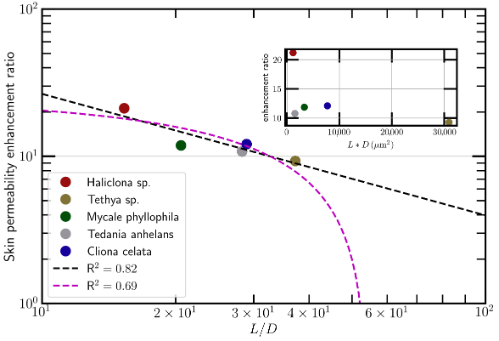Sponge spicules have recently been utilized as scattered microneedles to disrupt the skin barrier and enhance the skin penetration of a series of therapeutics and even nanoparticles. Spicules can physically disrupt skin in a dose-dependent manner and be retained within the skin over a long time, which provides a convenient, safe, and effective skin delivery strategy.
1. Introduction
Skin delivery of therapeutic peptides offers many advantages over systemic administration (injection or oral administration), such as the evasion of the first-pass effect, controlled drug release over time, direct access to local lesions, and good patient compliance, among others. However, the skin barrier, composed primarily of Stratum Corneum (SC), generally results in low skin absorption and, consequently, low bio-availability of therapeutics. In order to overcome the skin barrier for enhanced skin delivery of therapeutic peptides, lots of methods have been utilized, including physical methods such as iontophoresis, electroporation, and microneedles; and chemical ones, such as penetration enhancers and nanoparticles, among others. Physical methods are usually involved with the relatively high cost and uncomfortable feeling (burns or pain) to the skin. In contrast, chemical ones usually have limited effectiveness for enhanced skin delivery. In addition, long-term use of some chemical penetration enhancers can even damage the skin barrier structure, causing skin irritation and allergy. Sponge spicules have recently been utilized as scattered microneedles to disrupt the skin barrier and enhance the skin penetration of a series of therapeutics and even nanoparticles.
2. Current Insights
The skin delivery of therapeutics is usually limited by the SC barrier despite the fact that it can avoid both GIT degradation and first-pass metabolism with better patient compliance. Spicules has been utilized as a novel kind of microneedle to create plenty of micro/nano-channels across the SC layer and, consequently, enhance the skin delivery of therapeutics or even nanoparticles. Thus, the enhancement of skin permeability induced by spicules should be positively correlated with the amount of micro/nano-channels per unit area and channel pore size. The amount of micro/nano-channels should be proportional to the number of spicules per unit weight and subsequently be inversely proportional to the volume of a single spicule (LD2). On the other hand, the channels induced by spicules are circular gaps (G) between skin and spicules. Considering the channels’ pore size is ¼π((D + G)2 − D2), the pore size should be proportional to the spicules’ diameter (D), considering that G (size of nm) is much smaller than D (size of μm). Finally, the enhancement ratio (ER) of skin permeability induced by spicules should be inversely proportional to the product of the spicules’length and diameter (LD product).
We obtained a series of spicules from different sponges, including Haliclona sp., Mycale phyllophila, Tedania anhelans, Tethya sp. as well as Cliona celata. Sponge Haliclona sp. spicules (SHS) are spindle shaped oxeas. Sponge Mycale phyllophila spicules, sponge Cliona celata sp. spicules and sponge Tedania anhelans spicules are unicuspidate subtylostyle. Sponge Tethya sp. spicules are composed of two types of spicules, strongyloxea and spheroxyaster. However, we found a better correlation between the skin permeability enhancement induced by spicules and their aspect ratio L/D (Figure 1. log10(ER) = 2.25 − 0.83log10(L/D), R2 = 0.82).
Figure 1. The correlation between the skin permeability enhancement ratio (ER) and the aspect ratio of spicules (L/D). Both linear and power-law fittings are shown as purple and black dashlines, with an R2 of 0.69 and 0.82, respectively.
Both linear and power-law fittings are considered via a least-square fit algorithm. They provide a slope of −0.46 and a scaling exponent −0.83, respectively, with R2 being 0.69 and 0.82. Visually, the power-law fitting provides a better description of the experiment data. It also provides a reasonable asymptotic value zero when L/D approaches infinity while the linear fitting is unbounded. Note that the power–law relation is often found in a complex system where the so-called similarity emerges spontaneously. However, due to the limited number of experimental cases, the power–law relation should be verified in the future with more cases, e.g., L/D > 40 or L/D < 10. Further, it should be pointed out that although porcine skin is widely accepted as a surrogate for human skin, it is a critical variable to make predictions on the behaviors of spicules on skin when using different skin models. More studies need to be carried out in the future, with more spicules and in ex-vivo human skin, to confirm the correlation found in this study. In addition, currently this correlation is very preliminary. The exact physical significance of the good correlation between ER and L/D could be further investigated in the future.
According to the finding mentioned above, Sponge Haliclona sp. spicules (SHS) were selected to be used for transdermal or dermal delivery of two therapeutic peptides. One is insulin (INS), a hydrophilic peptide for diabetes treatment and another one is cyclosporine A (CysA), a hydrophobic peptide for psoriasis treatment. And we found that INS and CysA can be administrated via transdermal or dermal route by using proper spicules-based topical delivery systems in vitro and in vivo.
This entry is adapted from the peer-reviewed paper 10.3390/pharmaceutics13122119

